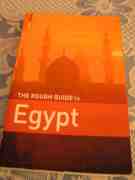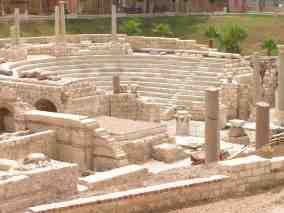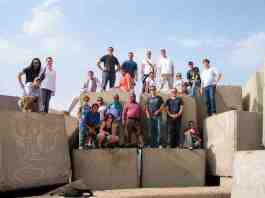My time in Egypt is almost at an end. I leave in four days to head over to Athens. The finality of my time left here in Cairo seems an appropriate time to think about my experiences here. As with most things dealing with pros and cons, a top 10 list seemed appropriate.
The TOP 10 Things I WILL NOT Miss about Cairo
10. Solicitation. This frequent occurence grates on my nerves in the worst way. Walking down the street, touring monuments, and even eating dinner will afford a few people who want to sell you something or another. It get’s old. I think I have said, “La, Shukran” (no thank you in Arabic) more than any other phrase I have ever used before.
9. The sidewalks. Walking around Cairo is an adventure. Pot-holes here are HUGE!! They along with cars parked on the sidewalks, steps, and curbs that are at least 15 inches tall everywhere (this is I have come to believe is used to keep the cars actually on the road, sort of like the blow-up things they put in bowling alley lanes for children so the ball never goes in the gutter) make walking interesting to say the very least. I told my friends that I felt walking around Cairo was like negotiating an obstacle course…I kept waiting for the giant mushrooms to come out that I would have to jump over/on (this joke only applies to those who have ever played Mario Bros. on Nintendo).
8. Traffic. The traffic in Kenya was bad…Cairo traffic is worse. In Cairo they have the benefit of fairly decent roads (due to their economy and weather with little or no variation). The drivers take advantage of these roads to drive like insane people!! I have actually come to not mind this so much. I no longer fear accidents or death…I just enjoy the ride. The traffic also lends itself to adding an interesting variation to walking around Cairo as crossing the street is often as interesting as a high level game of Frogger. I admit that I am a little nervous that these bad habits I have observed will influence my driving when I get home. Let’s hope not.
7. Baksheesh. (Bribe in Arabic.) Basically everyone in Egypt can be bought. Police will accept a bribe to show you a closed tomb. Cab drivers expect it. Bathroom attendants want it. I’m done with it. No more baksheesh from this lady.
6. Bargaining. I hate bargaining. Enough said.
5. Western women stereotypes. Nearly all Egyptian men think western women are whores. I don’t exaggerate this point at all. They don’t just think the women are slutty….they think they are prostitutes. This notion is largely from American cinema and then fueled by the scantly clad women tourists who visit the country. It will be nice to head to a country (Greece first and then America) where tank tops, white skin, and showing off ones knees do not equal being a whore.
4. Flushing toilet paper. It’s a simple as it sounds. The Egyptian septic system can’t handle toilet paper so it is thrown in a trash can beside the loo. Won’t miss this at all.
3. Islamic Society. I have learned so much from living in a muslim culture, yet I will be very happy to return to a secular society where religion takes, at least somewhat of a backseat to the functions of society. You may not have known this but Egypt actually has it written in the Constitution that polytheism and atheism are illegal. Can you believe it? I was incredibly frustrated with Egyptian society one night, and began a Stella (Egyptian beer) induced rant about how I was converting to polytheism and adhereing to the Olympian order. Oppression really makes me want to rock the boat! Of course add frustration with a foreign culture, a couple of beers, 110 degree heat, and maybe you too would want to change religions to make a statement. I have since calmed down.
2. The pollution. Living in a city of 20 million people is bad for my asthma. My lungs hate me.
1. Solicitation from Egyptian men manifesting itself often as kissy noises and crude Arabic slurs. I HATE this about Egypt. A woman can’t walk anywhere in this country without being objectified in terrible ways. Until my ipod finally died (RIP Dex) I would walk around the streets when I was alone with my sunglasses on and my ipod in so I would not hear the taunting. After Dex broke I had the opportunity to practice my glare and got to shout “la’ah” (hell no) or “harram” (forbidden) at my offenders in Arabic. You grow a little callous to it, sure, but wow is it ever annoying! What is even more annoying is that this does not happen when you walk with men. Because women are men’s property you know!! Aaahhhh!!! Before I leave I am ordering Egypt a sexual revolution. Stat.
10 Things I WILL Miss About Cairo
10. The prices. Egypt is a cheap country to live in, can’t beat that.
9. History. I love ancient history. Being surrounded by the pyramids and easy access to history I have only seen in books so far is incredible. America is a young country. We restore buildings to how they looked “over fifty years ago” (all the Eddie Izzard fans will love that). Life here is much older: you can feel it, you can see it.
8. Kushari. One of Egypt’s finest contributions to cuisine. A delicate combination of rice, pasta, lentils, dried onions, chickpeas, and tomato sauce that is AMAZING. Kushari joints are little hole in the wall restaurants where all you can order is kushari in small, medium, or large. A small kushari and a bottle of water for lunch cost about 5 Egyptian pounds or $0.90. Can’t beat that!
7. Teaching English in Giza. I hope to blog about this experience in greater depth later, but while I was here I worked with a refugee program and taught English to Iraqi refugees and Christian evacuees from Upper Egypt twice a week. Each trip out to Giza took about an hour via microbus and trekking through slums, but the journeys were all worth it. My students where so warm and kind they absolutely made my day each time I saw them. It was the hi-light of my week for five weeks.
6. Sheesha. This is an Egyptian past time that I love! Sheesha, or hooka, is flavored tobacco smoked through a water pipe. The streets of Cairo are lined with sheesha bars that help fill Cairo with some wonderful smells. I would often sit in these sheesha joints until all hours of the morning spending time with my friends. Bars are not how people spend time together here as Muslims do not drink alcohol, sheesha is their vice and it’s a good one.
5. Turkish Coffee. Lots and lots of Turkish coffee.
4. The poverty. I know this may seem like a strange thing to miss but for me it is a great learning experience each and every day. I have had a lot of time to think here in Cairo. Mostly I spend this time fretting about my life; student loans, career path, failed relationships, and the rest of life than can get me into a pretty yucky place if I let it. Here though, you can’t think too much about yourself. Society won’t let you. It’s hard to think that your life is hard when you pass mothers with month old babies and old women in the streets who try and sell packets of tissue to make enough money to eat. There are also throngs of street children, mostly boys, who have been kicked out of their homes (mostly because once boys hit the age of 13 they can’t be alone with women according to Islamic law, and since most of their families live in one room homes the boys are left to their own devices) and left to beg on the street. About 30% of them die within one year. All of a sudden my life looks easy. I hope to bottle this feeling and carry it with me wherever I go.
3. Fruit juice. Pulp lovers would be so at home here in Egypt. All of their fruit juices are basically blended versions of the fruit. Strawberry and Mango are my favorite, you can bet money that I am going to drink as many as I can in the next four days!
2. Public Transport. I love my Jeep but give me a metro and bus system and I don’t think I would ever drive.
1. My friends. I have met some of the most amazing human beings here in Cairo. They come from all over the globe: Australia, Lebanon, Switzerland, England, and the US. I will miss them all terribly when I leave. They made my trip here a wonderful experience and I am deeply grateful.
I suppose those lists don’t sum it all up, but it comes pretty close. I really did love Egypt. I would never want to live here full time, but I got to see a side of the country most tourists never see. Though, I am happy to be returning home and will never be more excited to see a Starbucks venti soy latte, I will miss it here. I learned so much. I felt so much. I even ended up with a copy of Harry Potter and the Deathly Hallows on the day of its release. You can’t ask for more than that.















